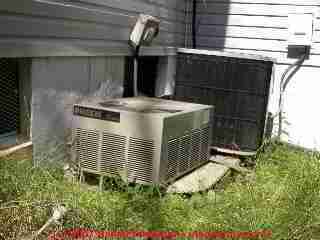 Air Conditioner / Heat Pump Compressor & Condenser Installation Errors
Air Conditioner / Heat Pump Compressor & Condenser Installation Errors
- POST a QUESTION or COMMENT about installing air conditioners and heat pumps: clearances, distances, leveling requirements
A/C or heat pump compressor/condenser unit installation mistakes:
This air conditioning repair article discusses the installation errors in air conditioning compressor and condensing units such as improper location, blocked air flow, out of level, or not properly supported.
We discuss required equipment clearance distances, refrigerant line piping support and routing, and problems with shrubbery or other air flow blockages that can cause overheating, higher operating costs, and reduced compressor motor life.
InspectAPedia tolerates no conflicts of interest. We have no relationship with advertisers, products, or services discussed at this website.
Air Conditioning or Heat Pump Compressor / Condenser Unit Installation Errors & Damage
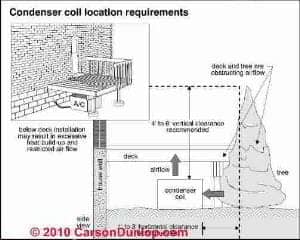
A/C and heat pump compressor/condenser installation, location, and maintenance tips provided here include attention to compressor support pads and avoiding air conditioning refrigerant leaks are addressed.
If readers return to the first chapter or view the A/C chapter index, the major components of an air conditioning system are described, sketches and photographs are provided, and common defects for each component are listed along with visual or other clues that may suggest a problem or probable failure of A/C components.
Sketch at left provided courtesy of Carson Dunlop Associates, a Toronto home inspection, education & report writing tool company [ carsondunlop.com ].
If your air conditioning or heat pump system has lost its cooling capacity or won't start
see REPAIR GUIDE for AIR CONDITIONERS.
See HOW TO DETERMINE COOLING CAPACITY of air conditioning equipment if the system seems to be working but is inadequate to cool your building.
Air Conditioning Compressor Location Problems
Inadequate air circulation clearance around an air conditioner compressor/condenser unit

Typical outside air-cooled A/C compressors require a minimal clearance around the unit to provide adequate air flow so that the condenser coils will be cooled efficiently.
Both of the air conditioning installations shown above are tipping and the left hand compressor/condenser unit was actually leaning on the house wall!
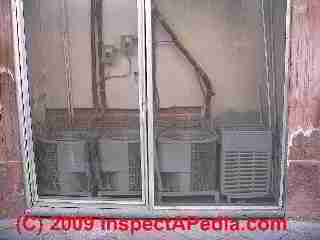
Air conditioning compressor/condenser units mounted too close to a wall, surrounded by shrubs, or multiple units located too closely together may not receive enough cool air flow to function properly.
The result can be a shorter compressor life (expensive) and/or less efficient cooling operation (higher operation costs).
These four air conditioner compressors were found jammed into a wall niche along a street in Queretero, Mexico. These units may have a short life before needing replacement.
Where there simply is not adequate space to provide proper air circulation around an air conditioning compressor or multiple compressors, it may be a good idea to let the building owner know that the units won't have a long life.
Air Conditioner Compressor/Condenser Units Overgrown with Shrubbery
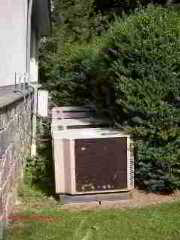
This collection of air conditioning compressors are too many too close together - they will be fighting for cooling air around the condenser unit, increasing operating cost and shortening air conditioner compressor life.
Adding to this scene is the overgrowth of shrubs along the compressor/condenser units. The owner didn't want to see these "ugly" devices but she should have kept the plants trimmed off of the units themselves to allow airflow.
The shade was a great idea however, so long as these are just air conditioning units and not heat pumps that want warmth in winter.
One of our clients was "punished" by their air conditioner installer when she said that she didn't want to see or hear the compressor/condenser units, and when she was installing nine of them at her large home.
The installer built a rack allowing the units to be stacked on top of one another, three across and three high, with very little air space between.
Then the installer put up a stockade fence just a few inches away from the compressor/condenser units. They were hard to see, it was true, and hard to service. But as the property manager confirmed, they were having to replace several of these units every few years.
I believe it was because the units ran excessively hot all the time, lacking adequate air and clearance. Photo withheld for privacy.
Details are at
- CLEARANCE DISTANCE, HVAC - working space, air flow, fire safety, etc.
- COMPRESSOR/CONDENSER SHADE BENEFITS? - build a shade roof over the condenser unit?
Air Conditioner Refrigerant Line Defects
Please see our detailed article about refrigerant line piping installation, inspection, defects, repairs, found
at REFRIGERANT PIPING INSTALLATION. Excerpts below:
Refrigerant Line Mounting Requirements
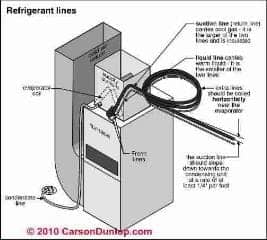
Absence of slack in the coolant lines at the compressor units can cause leaks: should the compressor move, perhaps because its supporting pads settle, there will be likely leaks at these lines. You should review this question with your HVAC service person. This item may be deferred until next maintenance or service.
Protection from mechanical damage on all refrigerant lines is important to prevent leaks.
CarsonDunlop Associates' sketch (left) shows the indoor air handler unit, not the outside compressor/condenser unit, but the illustration makes clear that the refrigerant piping loop needs to be properly placed and the piping slope should be downwards from the evaporator unit towards the compressor/condenser unit.
Also, referring lines should not be buried underground.
Details are at REFRIGERANT PIPING INSTALLATION.
Refrigerant Line Insulation Requirements
Missing insulation On the refrigerant lines, particularly on the larger suction line, will cause condensation and drips from the lines in humid areas. I've seen very costly building damage where lines were not properly insulated indoors: condensate drips wet gypsum board walls, leading to a costly mold remediation project.
Missing insulation on the refrigerant piping also probably increases system operating cost. Details are
at REFRIGERANT PIPING INSTALLATION and
at REFRIGERANT PIPING INSULATION.
Minimum Clearance Distances from Building Walls, Shrubs, Other Equipment
Blocking air flow through the outdoor A/C or heat pump compressor/condenser unit is a really bad idea that shortens equipment life (as the equipment runs hotter) and increases system operasting costs (for the same reason - hotter opeating temperature means lower efficiency during the cooling season).
Air conditioning or heat pump compressor/condenser units mounted too close to a wall, surrounded by shrubs, or multiple units located too closely together will probably not receive enough cool air flow to function properly.
And even worse, compressor/condenser units that are too close together not only have to fight for their incoming cooling air, but they may veed hot exhaust air to one another, increasing their operating temperatures still further.
Details about the recommended clearance distances for A/C or heat pump compressor/condenser outdoor units are found
Air Conditioning Compressor/Condenser Unit Support Pads - Leveling Requirements for Compressor/Condenser Units
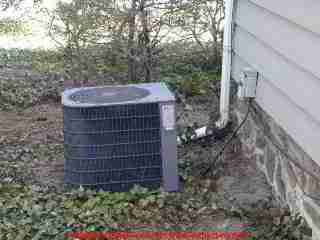 Outside A/C compressors are typically supported on
a concrete pad, concrete blocks, or a vinyl pad such as the one shown in the photo at page top.
The air conditioner compressor support pad should be level and secure against movement.
Outside A/C compressors are typically supported on
a concrete pad, concrete blocks, or a vinyl pad such as the one shown in the photo at page top.
The air conditioner compressor support pad should be level and secure against movement.
Compressors which are badly out of level may fail to function properly and need adjustment.
Tipping and moving compressors can also cause can cause leaks in refrigerant lines, leading to costly air conditioning service calls to evacuate and recharge the system after repairing the refrigerant leak.
Do not try to move your A/C compressor yourself as you might cause a refrigerant leak or may otherwise damage the equipment.
Ask your A/C service technician to evaluate the effects of any out-of-level conditions of the compressor as well as to comment on the available slack in the refrigerant lines that may be needed to reposition the unit.
For slightly-tipped air conditioning compressors we generally leave them alone but we add support as needed to avoid further movement.
Tipped or leaning air conditioner compressor/condenser units
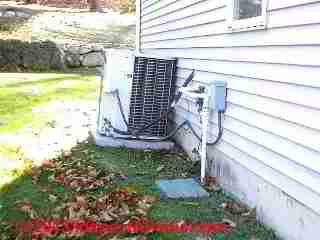

Tipping or leaning air conditioner compressors can lead to so much movement that the refrigerant lines crack and leak, leading to loss of cooling ability. In extreme cases, a tipped condenser unit may fail to operate properly. In the first photo above the compressor is leaning and creeping away from the building and has pulled its connecting wiring and refrigerant line taut.
I expect a problem soon with this unit. In the second photo everything looks awful: the two compressors are too close together and too close to the building wall for adequate air circulation, especially in the larger rear unit in the photo.
The safety electrical switch for the air conditioner is falling off of the wall, and the rear unit is sliding off of its support pad.
This was a poor air conditioning system installation.
Reader Comments, Questions & Answers About The Article Above
Below you will find questions and answers previously posted on this page at its page bottom reader comment box.
Reader Q&A - also see RECOMMENDED ARTICLES & FAQs
On 2018-08-28 by (mod) - distance a heatpump has to be away from a oil tank?
Mark
at OIL TANK INSPECTION & TROUBLESHOOTING inspectapedia.com/oiltanks/Oil_Tank_Inspection_Reports.php we give oil tank clearance distances - you'll see that there was no consideration of heat pumps when those standards were first written
at CLEARANCE DISTANCE, HVAC inspectapedia.com/aircond/HVAC_Clearance_Distances.php we list all the known clearance distances for the heat pump / air conditioner equipment such as the compressor/condenser unit.
There too nobody was considering oil tanks.
That leaves your local building code inspector as the final legal authority. Sorry but I didn't find more specific rules other than the general guide to keep four to eight feet between the compressor/condenser unit and other mechanical systems or equipment - that might be interpreted to include an oil tank fill valve and vent and thus implicitly the oil tank itself.
On 2018-08-22 by Mark
Is there a distance a heatpump has to be away from a oil tank?
On 2018-05-08 - by (mod) -
Yes in conduit though there are issues and costs that make buried refrigerant lines not recommended.See details at REFRIGERANT PIPING UNDERGROUND, BURIED
On 2018-05-08 by traveling mom
Can the outdoor pipes and electrical lines be buried from the house to the outdoor unit?
On 2017-07-31 by Kathy Finlay
 How far away from the house wall and a window be?
How far away from the house wall and a window be?
On 2017-07-13 by (mod) - free unobstructed air clearance required above chiller units
I think you're asking about protecting the chiller from sun - by providing shade?
A review of Carrier's air cooled chiller installation manual and Trane's commercial chiller manual for their RTAA both confirm what I thought: the chiller requires these clearance distances:
- Unobstructed overhead air clearance for its exhaust. You cannot build something overhead for shade without discussing your installation with the manufacturer of your specific unit brand and model
Trane excerpt:
b. Provide Vertical Clearance Vertical condenser air discharge must be unobstructed. While it is difficult to
predict the degree of warm air circulation, a unit installed as shown on the left would have its capacity and
efficiency significantly reduced. Performance data is based on free air discharge.
- 6 feet of clearance horizontally on the air inlet sides for air inlet to the chiller unit
- 5 feet of service clearance on the other sides of the equipment
Sources:
- CARRIER AIR CONDITIONERS BOILERS FURNACES AGE MANUALS
- Class-3 Commercial HVAC Chiller Equipment, Air Cooled Chillers, [PDF] (2016) Carrier Corporation available widely online and from Carrier or from us
- Trane Air-Cooled Series R™ Rotary Liquid Chiller Model RTAA 70 to 125 Tons [PDF] (2002) availble from Trane Corporation or from us
- TRANE AIR CONDITIONERS & HEAT PUMPS
On 2017-07-13 by Anonymous
I have installed an air cooled chiller of 80Ton, I wish to shad on it, tell me know the any standard for height b/w chiller top to shad?
...
Continue reading at CLEARANCE DISTANCE, HVAC or select a topic from the closely-related articles below, or see the complete ARTICLE INDEX.
Or see COMPRESSOR / CONDENSER INSTALL ERROR FAQs - questions & answers posted originally at this article
Or see these
Recommended Articles
- CLEARANCE DISTANCE, HVAC
- COMPRESSOR / CONDENSER REPAIR - topic home
- REFRIGERANT PIPING UNDERGROUND, BURIED
- REFRIGERANT PIPING INSTALLATION
Suggested citation for this web page
COMPRESSOR / CONDENSER INSTALLATION ERRORS at InspectApedia.com - online encyclopedia of building & environmental inspection, testing, diagnosis, repair, & problem prevention advice.
Or see this
INDEX to RELATED ARTICLES: ARTICLE INDEX to AIR CONDITIONING & HEAT PUMPS
Or use the SEARCH BOX found below to Ask a Question or Search InspectApedia
Ask a Question or Search InspectApedia
Try the search box just below, or if you prefer, post a question or comment in the Comments box below and we will respond promptly.
Search the InspectApedia website
Note: appearance of your Comment below may be delayed: if your comment contains an image, photograph, web link, or text that looks to the software as if it might be a web link, your posting will appear after it has been approved by a moderator. Apologies for the delay.
Only one image can be added per comment but you can post as many comments, and therefore images, as you like.
You will not receive a notification when a response to your question has been posted.
Please bookmark this page to make it easy for you to check back for our response.
Our Comment Box is provided by Countable Web Productions countable.ca
Citations & References
In addition to any citations in the article above, a full list is available on request.
- Thanks to Scott at SJM Inspect for suggesting the EPA air conditioning and IAQ document and for technical editing remarks regarding our air conditioning website, SJM Inspection Service LLC, serves the entire state of CT, sjminspect.com 203-543-0447 or 203-877-4774 5/16/07
- Thanks to Diaz, Domingo I. CIV NAVAIR Bldg.2118, rm. 131: domingo.diaz@navy.mil - Ming Diaz, Great Falls, MD for editing help with the text about discharging air conditioning compressor capacitors - 3/07 DF]
- Thanks to reader (Anon) for discussing the allowable distance between air conditioner compressor and a building or from the air handler - July 2010
- ASHRAE Handbook Refrigeration, Chapter 2, 2006. © American Society of Heating, Refrigerating and Air-Conditioning Engineers, Inc., www.ashrae.org
- REFRIGERANT PIPING GUIDE [PDF] , McQuay Corporation, Americans HQ: 13600 Industrial Park Blvd., Minneapolis, Minnesota 55441, 800-432-1342 (Toll Free)
763-553-5330 (Direct), 763-553-5177 (Fax). Web search 07/15/2010 original source: http://www.mcquay.com/mcquaybiz/literature/lit_systems/AppGuide/AG_31-011_120407.pdf - quoting:
McQuay International delivers engineered, flexible solutions for commercial, industrial and institutional HVAC requirements with reliable products, knowledgeable applications expertise and responsive support. As part of Daikin Industries, a Fortune 1000 company, McQuay is the second largest air conditioning, heating, ventilating and refrigeration company in the world. - Our recommended books about building & mechanical systems design, inspection, problem diagnosis, and repair, and about indoor environment and IAQ testing, diagnosis, and cleanup are at the InspectAPedia Bookstore. Also see our Book Reviews - InspectAPedia.
- Complete List of Air Conditioning & Heat Pump Design, Inspection, Repair Books at the InspectAPedia Bookstore.
- Modern Refrigeration and Air Conditioning, A. D. Althouse, C.H. Turnquist, A. Bracciano, Goodheart-Willcox Co., 1982
- Principles of Refrigeration, R. Warren Marsh, C. Thomas Olivo, Delmar Publishers, 1979
- Refrigeration and Air Conditioning Technology, 5th Ed., William C. Whitman, William M. Johnson, John Tomczyk, Cengage Learning, 2005, ISBN 1401837654, 9781401837655 1324 pages
- Air Conditioning SEER - New DOE Air Conditioner and Heat Pump Efficiency Standard
- In addition to citations & references found in this article, see the research citations given at the end of the related articles found at our suggested
CONTINUE READING or RECOMMENDED ARTICLES.
- Carson, Dunlop & Associates Ltd., 120 Carlton Street Suite 407, Toronto ON M5A 4K2. Tel: (416) 964-9415 1-800-268-7070 Email: info@carsondunlop.com. Alan Carson is a past president of ASHI, the American Society of Home Inspectors.
Thanks to Alan Carson and Bob Dunlop, for permission for InspectAPedia to use text excerpts from The HOME REFERENCE BOOK - the Encyclopedia of Homes and to use illustrations from The ILLUSTRATED HOME .
Carson Dunlop Associates provides extensive home inspection education and report writing material. In gratitude we provide links to tsome Carson Dunlop Associates products and services.


